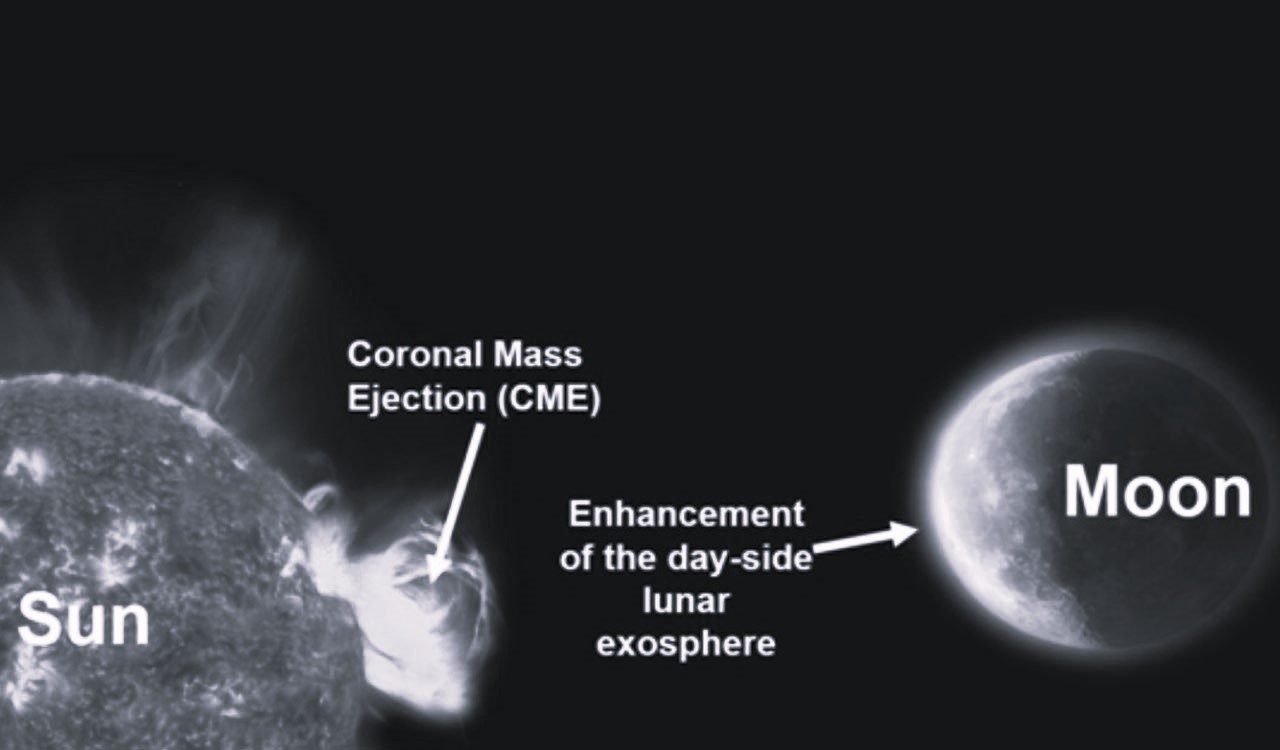
Chandrayaan-2 witnesses Sun’s fury on Moon
India’s Chandrayaan-2 lunar orbiter, using its instrument CHACE-2 (Chandra’s Atmospheric Composition Explorer-2), has for the first time observed the effect of the Sun’s Coronal Mass Ejection (CME) on the Moon’s exosphere. When a CME struck the Moon on May 10, 2024, CHACE-2 detected a significant rise in the total pressure of the dayside lunar exosphere, with the number density of neutral atoms and molecules increasing by more than ten times. This observation confirms earlier theoretical predictions but is now observed directly.
The Moon’s exosphere is an extremely thin atmosphere where gas atoms and molecules rarely interact. It is a surface-bound exosphere, meaning the Moon’s surface itself forms its lower boundary. The exosphere is created mainly through:
• Solar radiation
• Solar wind (Hydrogen and Helium ions, plus minor heavier ions)
• Meteorite impacts, which release surface atoms into the exosphere
The Moon lacks a global magnetic field, so it cannot shield itself from solar events like CMEs. A CME involves the Sun ejecting large quantities of plasma, mostly Hydrogen and Helium ions. When this plasma strikes the Moon, it enhances the release of atoms from the surface, temporarily increasing the exosphere’s density and pressure.
This observation provides:
• Scientific insight into lunar exosphere dynamics and lunar space weather
• Practical implications for future lunar bases, as architects need to account for extreme space weather events that temporarily alter lunar conditions
Coronal Mass Ejections (CMEs) are massive bursts of solar plasma and magnetic fields, mainly composed of charged particles like electrons, protons, and helium nuclei. They form when twisted magnetic field lines in the Sun’s corona suddenly reconnect, releasing huge clouds of plasma into space. CMEs strongly impact the Moon, which lacks a magnetic field and thick atmosphere to shield it. High-energy particles strike the lunar surface, knocking atoms and molecules into the ultra-thin exosphere and temporarily increasing its density. India’s Chandrayaan-2, using the CHACE-2 instrument, observed this for the first time on May 10, 2024, detecting a more than tenfold rise in exospheric particles. This discovery provides key insights into lunar space weather and aids planning for future lunar bases.
ISRO did not release actual photos of the CME’s effect on the Moon because the CHACE-2 instrument onboard Chandrayaan-2 is a mass spectrometer, designed to measure the composition and density of atoms and molecules in the lunar exosphere, not capture images. Moreover, CMEs themselves are invisible to the naked eye, consisting of plasma and magnetic fields that require specialized instruments to detect. The changes caused by a CME on the Moon involve microscopic particles being knocked off the surface, which cannot be photographed. Scientists instead observe these effects through data plots and graphs that represent variations in particle density and pressure. This approach ensures accurate scientific reporting in line with peer-reviewed research, even though it doesn’t produce visual images.
Reference: Dhanya, M. B., Chemukula, Mathin Yadav, Smitha V. Thampi, Tirtha Pratim Das, Satheesh Thampi, R., Anil Bhardwaj. _Impact of a Coronal Mass Ejection on the Lunar Exosphere as Observed by CHACE-2 on the Chandrayaan-2 Orbiter_ . Geophysical Research Letters, 52(15), 2025GL115737, 16 AUG 2025.
